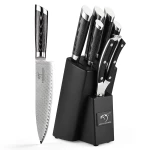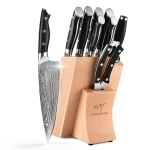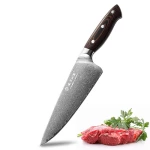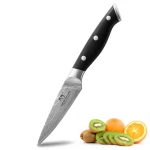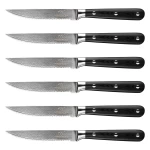What Materials are Used in Making Chef's Knives? A Guide to Steel, Handle Materials, and More

Chef's knives are crafted from a variety of materials, each contributing to the knife's performance, durability, and aesthetic appeal. Here's a comprehensive guide to the materials commonly used in making chef's knives:
Blade Materials:
1.Stainless Steel:
High-Carbon Stainless Steel: Combines the durability of carbon steel with the corrosion resistance of stainless steel.
VG-10: A type of stainless steel known for its exceptional edge retention and resistance to rust and corrosion.
X50CrMoV15: A popular stainless steel alloy used in many high-quality chef's knives, known for its balance of hardness, corrosion resistance, and ease of sharpening.
2.Carbon Steel:
High-Carbon Steel: Offers excellent edge retention and sharpness but requires more maintenance to prevent rust and corrosion.
Blue Steel (Aogami): A type of carbon steel prized for its exceptional sharpness and edge retention, commonly used in Japanese chef's knives.
3.Damascus Steel:
Pattern-Welded Steel: Created by layering different types of steel together, resulting in a unique Damascus pattern and enhanced strength and durability.
Damascus Clad: A core of high-carbon steel is sandwiched between layers of softer stainless steel, combining the benefits of both materials.
Handle Materials:
4.Wood:
Traditional Choice: Wood handles offer warmth, aesthetics, and a comfortable grip. Common types include walnut, maple, and rosewood.
Maintenance: Requires periodic oiling to prevent drying and cracking.
5.Plastic (Polymer):
Durability: Plastic handles are durable, lightweight, and resistant to water and chemicals, making them easy to clean and maintain.
Hygiene: Ideal for commercial kitchens due to their non-porous nature, which prevents bacteria buildup.
6.Composite Materials:
G10: A type of fiberglass laminate known for its durability, stability, and resistance to moisture and chemicals.
Micarta: Made from layers of linen, canvas, or paper impregnated with resin, offering excellent grip and durability.
7.Metal:
Stainless Steel: Some chef's knives feature handles made from the same stainless steel used for the blade, providing a seamless and sleek design.
Copper or Brass: Offers a unique aesthetic appeal and can develop a natural patina over time.
Other Materials:
8.Bolster:
Steel or Brass: Located at the junction of the blade and handle, the bolster adds balance, stability, and protection to the knife.
9.Rivets:
Stainless Steel or Brass: Used to secure the handle scales to the tang of the knife, providing strength and stability.
10.Sheath or Knife Guard:
Leather, Plastic, or Wood: Protects the blade when not in use and prevents accidents when transporting the knife.
When choosing a chef's knife, consider your preferences for blade material, handle material, and overall design, as well as factors such as maintenance requirements, ergonomics, and budget. Each material has its own characteristics and advantages, so it's essential to find the right balance of performance and aesthetics for your culinary needs.

